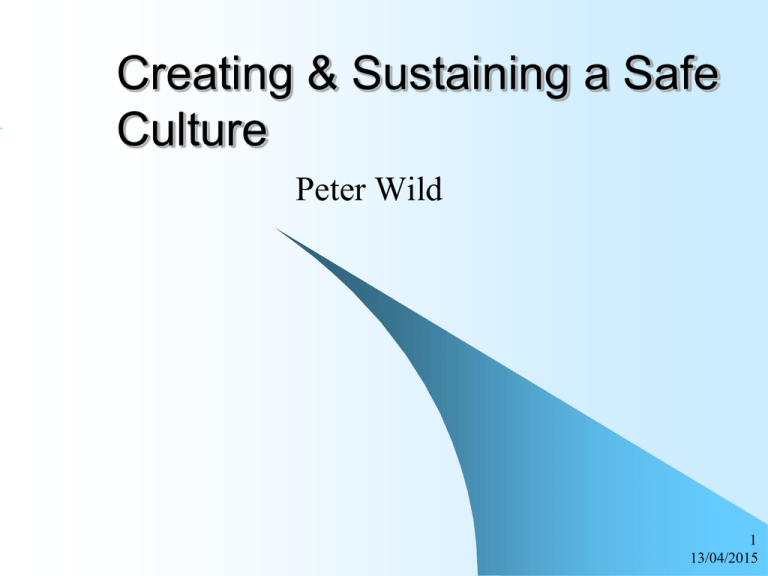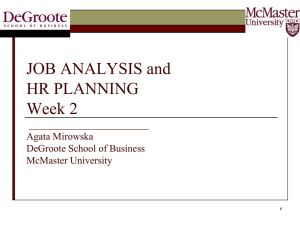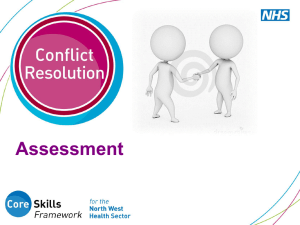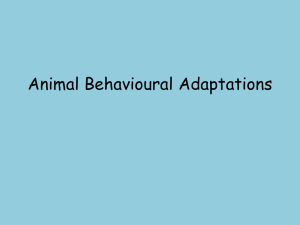
Creating & Sustaining a Safe
Culture
Peter Wild
1
13/04/2015
True safety has to be embedded in an
operating culture.
All Behaviours should be risk assessed
within the context and environment(s) in
which they occur.
This workshop will offer a paradigm in
which one can explore how to identify the
risk and resilience needed to create a
culture that promotes safety and wellbeing.
2
13/04/2015
The tasks required are relatively
straightforward.
To explore the hierarchy of
disruptive/dangerous behaviours.
To identify the risks presented in this
hierarchy.
To advocate training strategies to
minimise/manage these risks.
To provide care and after support to all
after the event(s).
3
13/04/2015
The principle underpinning the tasks is
breathtakingly simple…
Managing behaviour within a community
is an ongoing process which needs to be
systematically reviewed. The frequency is
determined by the risks posed. The
context of individual establishments can
vary enormously, both between themselves
and within themselves. Therefore any risk
assessment process which is adapted needs
to be bespoke.
4
13/04/2015
The behaviours can be classified simply
as…
Verbal behaviour – what we say – the words.
Para-Verbal behaviour – the way we speak –
intonation, speed, pitch etc.
Non-Verbal behaviour – what our body
communicates – does it match with what we are
saying?
Active behaviour – what we do.
Inaction - What we don’t do!
5
13/04/2015
The critical factors for calculating the risk
are:
Numbers involved in incident(s)
Severity of incident(s)
Frequency of incident(s)
The exponential nature of the relationship between
critical factors and consequences.
N x S x F = Risk Factor.
The higher and/or more complex the risk, the greater the
training needs become and the greater the monitoring and
evaluation needs to be.
6
13/04/2015
So, you need to have…
a format for risk assessing behaviours.
an indicative view of your training needs.
a clear view on what your next step is.
a sense of the on-going nature of the issues
involved.
A desire to see thoughts and words
translate into deeds.
7
13/04/2015
Risk Assessment and Behaviour Management
Support
Features
Risk Factor
Numbers
Involved
Severity Frequency Skills/
of
of
training
Incidents Incidents needs
Help essential……
Dangerous!
Extreme/
very High.
Single.
Few.
Many.
Extreme/
High.
Frequent.
Predictable?
Additional
physical skills/
training
needed.
Single.
Few.
Many.
Very high.
High.
Other.
Frequent.
Infrequent.
Predictable?
Other.
Physical/
verbal,
para-verbal,
non-verbal..
Single.
Few.
Many.
High/moderate.
Frequent.
Predictable.
Additional.
Verbal/
non-verbal..
Infrequent
Frequent.
Predictable?
Existing skills
adequate?
Help
Required……
Very difficult.
Difficult……..
Help preferable/ be
aware of availability.
Very high/
High.
High/ moderate.
Could easily become
difficult……
Help desirable, but
situation manageable.
Moderate/high.
Single.
Few.
Moderate/high.
Comfortable….
Manageable.
Moderate/low risk.
Single.
Few.
Moderate/low.
Infrequent.
Predictable?
O.K.
Risk Assessment – Within your depth and on your own.
Support
Features
Risk Factor
Numbers Severity
Involved of
Incidents
Frequency Skills/training
of
needs
Incidents
Could easily
become
difficult…..
Help desirable,
but situation
manageable.
Moderate/high.
Single.
Few.
Moderate/high
Infrequent/
Frequent.
Predictable?
Existing skills
adequate?
Comfortable…
Manageable.
Moderate/low risk.
Single.
Few.
Moderate/low.
Infrequent.
Predictable.
O.K.
Risk Assessment – within your depth, but preferring help.
Support
Features
Risk Factor
Numbers
Involved
Severity
of
Incidents
Frequency Skills/
of
training
Incidents needs
Difficult…..
Help
preferable/be
aware of
availability.
High/moderate.
Single.
Few.
Many.
High/moderate.
Frequent.
Predictable?
Additional.
Verbal/nonverbal.
Risk Assessment – Out of your depth….help
required/essential.
Support
Features
Risk Factor Numbers
Involved
Severity Frequency Skills/
of
of
training
Incidents Incidents needs
Help essential…..
Dangerous!
Extreme/
very high.
Single.
Few.
Many.
Extreme/
high.
Frequent.
Predictable?
Help required…..
Very difficult.
Very high/high.
Single.
Few.
Many.
Very high.
High.
Other.
Frequent.
Infrequent.
Predictable?
Other.
Additional
skills/
training
needed.
Physical/
verbal,
para-verbal,
non-verbal.
Strategic Behaviour
Management - Operating
Culture.
12
13/04/2015
Our Aim Is……
To ensure that the personal safety and wellbeing of all members of the community in
which we work,study and live is
maintained at an optimum level.
13
13/04/2015
Our Objectives are…..
To make xxxxxx a safe and healthy place
to be.
To promote and sustain safe and healthy
behaviours.
14
13/04/2015
We want to ensure that……..
Our xxxxx is as safe as it could be?
We have the means to assess this?
We have the means to address identified problems?
We have established clear priorities?
We can manage the consequences of our decisions (the
displacement factors) ?
15
13/04/2015
The Status Quo………….
Do we make assumptions that are no longer valid?
Do we collect and analyse relevant data in order to
inform our actions?
Do we give this issue a sufficiently high priority?
Do we have all the skills and support we need in order to
manage behaviour effectively?
16
13/04/2015
Should we …………
Review existing policies………are they relevant?
Review risk/behaviour assessment tools ………are they
Do they crossreference? Does everyone accept them? Does everyone implement them? How do we
know- Impact measures? (e.g. Behaviour policy, Health & Safety policy,
Exclusion/Induction policies, Special Needs, Child Protection, anti- bullying –
others?).
adequate? Can everyone use them? Do we allow enough time to analyse and respond
effectively?
Examine the Costs………………do we understand how to cost these
activities? Can we provide a budget for them? Do we factor in hidden costs; e.g..
Time Management? Do we understand the long term benefits? Are there knock-on
effects within this and other settings?
17
13/04/2015
Moving Forward………..
Can we say…’we know what we are going
to do, let’s do it.’ ?
What are the obstacles to progress?
18
13/04/2015
19
13/04/2015
20
13/04/2015
21
13/04/2015
22
13/04/2015
23
13/04/2015
24
13/04/2015
For further information contact:
Peter Wild
peterwild@wave2000.uk.net
Wild.peter54@gmail.com
© peter wild - all rights reserved
Permission granted to team-teach to reproduce for educational use only.
Commercial copying, hiring or lending is prohibited.
25
13/04/2015










